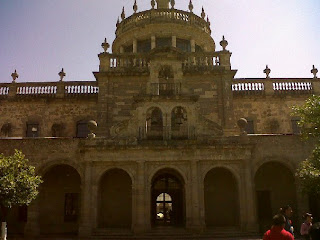Juan Pablo Gómez A01222488
In the image you can see that the cupula has an emphasis, and there is a great difference between the colors in the photo, the palace colors and the sky's colors.
In this paint it represents how the painter thought the independence was developed, and the importance that had Hidalgo in the independence it si reflected, when he did the "Grito de Dolores", and the colors that the painter used, I think that it is very clear that he used only warm colors.
This is a picture that I took when I was in Barcelona, I was walking in the streets of Barcelona when I arrive to this park close to Catalunya's Square, then I realize that what I was seeing was a great perspective as you can see too.
In this picture there is one of the terracota's soldiers and I saw it in the Palacio Clavijero in Morelia, and these soldiers are famous since one emperor of China order to built them, because they was afraid and he want to be protected by these soldiers. These soldiers are great, beacause they had a great relief and a lot of details.













